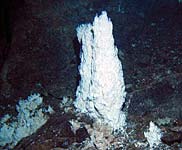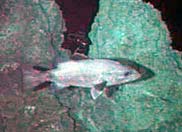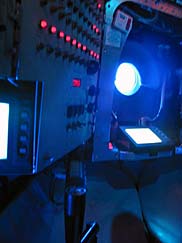|
|
|||||||||||||||||||||||||||||||||||||||||||||||||||||||||||||||||||||||||||||||||||||||||||||||||||
 |
|||||||||||||||||||||||||||||||||||||||||||||||||||||||||||||||||||||||||||||||||||||||||||||||||||
I had a pretty exciting day yesterday. Not that each day of a research cruise isn’t interesting all by itself, but yesterday was particularly special, because I had my first dive in Alvin. Yesterday morning, I hung out with a couple of my friends and made some jokes while waiting to get in the sub. After Pat, the day’s Alvin pilot, and Debbie, the other diver, got into the ball, it was my turn. I climbed up the set of stairs leading to the hatch, and was helped into the ball by Bruce, another member of the Alvin team. As I descended the ladder and wedged myself into the starboard (right) observer’s area, I started to get really excited. We began the dive by exploring a little topographic high, “The Hump”, to the southeast of Lost City. Pat landed Alvin directly over The Hump, and right away we saw little carbonate spires. He used a temperature probe to determine if the spires were actively venting, but they weren’t very hot. Then he used the manipulator arm to grab the top of the spire and break it off, resulting in our first sample. After a little more time and a few more samples, we decided to go to another area that had been visited the day before. We were hoping to find more actively venting structures, but couldn’t find the right spot. However, we managed to drive by a BIG spire and from my side of the sub, I could look down on it. It had to have been over 15 ft tall, and I couldn’t even see the bottom of it! Then we spotted the pressure sensor, which we deployed at the beginning of the cruise to measure tides. Pat quickly grabbed it and shoved it into the basket to bring it back onboard.
Having done our “chores” for the day, we got to start on our next objective: exploring the cliff edge to the east of Lost City, in the hopes of finding more areas of hydrothermal activity. As we began the transit, we saw lots of little carbonate “fingers” growing directly out of the wall. Because they are so light-colored, they stood out clearly from the dark rock walls.
After a little while, the fingers were replaced by veins of carbonate in the rock, and by pieces of carbonate that looked like they had rolled down from higher up on the cliff. However, there were lots of other things to look at, too. I saw many different corals, including gorgonians (fan corals). They were growing right out of the side of the cliff, and you could see them swaying in the current. I also got distracted by things swimming by my viewport. Like everybody else, I saw a bunch of big grouper (including one eating another fish! Wow!), but I also saw little purple eels, dark red shrimp, starfish, and one brittle star that decided to go for a swim just as we drove by!
We drove along the cliff face for about an hour, and only saw veins, carbonate rubble, and steep slopes of serpentinite. Because of this, Debbie decided that we should go further up the cliff, to trace where the carbonate was coming from. When we reached the top of the cliff, we found a broad, flat area that was covered in carbonate, and was the probable source for the pieces we found further down the slope. We grabbed a few samples to finish our exploration to the east. Pat flew us back to Lost City, and we circled around Poseidon, the huge structure in the middle of the field. We were on the lookout for an active vent structure, called the Beehive, that the previous Alvin dive had knocked over. We managed to find the site of venting and took some water samples from this 90°C vent. Then we searched until we found the shattered remains of the Beehive. While we were doing this, I was looking out the window at Poseidon. It’s so big that I couldn’t see the top, the bottom, or around the corner. It is simply unbelievably huge. After I gawked at it for awhile, we still had a little time left to explore to the west of Lost City. Along the western cliff, we saw beautiful outcrops of serpentinite, topped by breccias and carbonate. The rocks were really cool and led to discussions of how this area could have been formed. Eventually, the sub ran out of power (a normal occurrence) and Pat began our ascent. We took the time during ascent to organize our papers, listen to a little music (Pat brings his favorite CDs into Alvin), and chitchat about nothing in particular. After we surfaced, the sub was brought aboard by the Alvin team and Atlantis crew. I was the first person out of the ball, and was greeted by the science crew and five buckets of ice-cold water. Even that couldn't dampen my enthusiam for the great time I'd had diving in Alvin! |
|||||||||||||||||||||||||||||||||||||||||||||||||||||||||||||||||||||||||||||||||||||||||||||||||||



